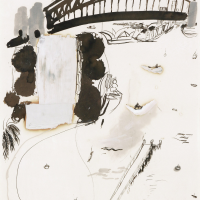38. BRETT WHITELEY

Even before he moved to Lavender Bay, Brett Whiteley had felt entranced by the contours of Sydney Harbour. He grew up in Longueville, a suburb on the lower north shorea short boat ride from his future homeand that was where he liked to play in the mangroves and explore the edges of a city that carried itself like a country town. It was here, too, that he began to admire Lloyd Rees who lived nearby, a vantage point that allowed the older artist to study the light and movement of his environment.
Then in 1969, the world behind him, Whiteley returned to this pocket of Sydney and looked again upon this scene. Now an artist of renown in his own right, he settled into Lavender Bay with his wife Wendy and their daughter Arkie. He shifted between themes and subjects, but the creative promise of this city and its surrounds would occupy his thoughts, on and off, for the next two decades. A great transmutation, he declared, is at hand in Australia!1
What a gift to art: through these windows, Whiteley watched the city grow. He watched the Sydney Opera House take shape. He watched the boats and the birds and the waves. A new lyricism was upon him. And the light was fkin amazing. The light in Sydney was like nowhere else; a distinct contrast to the muted, evanescent sunshine that characterised life in southeast England.
Artists can only respond, of course, to the world around them. Harry Seidlers offices and apartments in Milsons Point, completed in 1973, were as much a part of Sydneys visual narrative as any landmark, natural or otherwise, around town. If Whiteley was still with us now, what recent developments might have caught his eye? Perhaps that new one across the harbour in Barangaroo, the luxury tower that happens to face another Seidler creation, each one standing tall, as conspicuous on the waters edge as the other, and both a part of the citys story, for better and worse.
But back to 1976, and Whiteleys invocation of Harrys building. The name suggests a familiarity between the architect and the artist, though the pair werent ever really friends. Its a note of affection, and respect, consistent with the way Whiteley describes his peers through history: Piero, Vincent, Diebs (Richard Diebenkorn).
The features of the city are there the bridge across the top, the Opera House and the coastline, too, which bends in his hand with the curves of a womans body. Whiteley needs only a few lines to convey the curves on that bay, and the pier, and the cloud, and the vessels on the water, and the water itself. Such is the fluency of his line and his arrangement of space. Whiteley is the master of evocative simplicity, a quality that defines many of his Lavender Bay pictures, ensuring their endurance and their maddening resistance to imitation.
And then theres the building, viewed from the side and cloaked with trees that stand to this day, that gives this picture its title: two rectangles laid flat, a textural and geometric contrast to the rest of the image. Are we tempted to see its presence as an artificial incursion on the landscape, a view interrupted? This is Sydney, after all, where everyone has an opinion on real estate, especially of the waterfront variety. Whiteley the neighbour, the artist, the student forever studying the shapes of Sydney offers a more generous response. He encourages a romance in many forms. The temptation, then, is to embrace Harrys building as a part of the citys character, a key part of a story that continues to evolve.
Footnotes:
1. Brett Whiteley, quoted in Wilson, A., Brett Whiteley: Art, Life and the Other Thing, Text Publishing, Melbourne, 2016, p.212
Ashleigh Wilson
Ashleigh Wilson is the author of Brett Whiteley: Art Life and the Other Thing (Text Publishing, Melbourne, 2016).